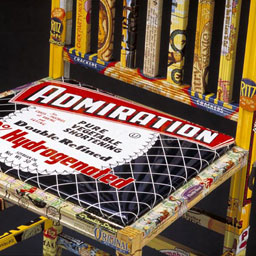Consuming Identity Chair
Consuming Identity mounts on the wall, an object floating between the iconic identity of a Charles Rennie MacKintosh chair and the craftsmanship of a Shaker chair. This is a sculpture about creating an identity in our consumer society by what we buy and why we buy it. Though it looks like a chair, it is not for sitting. The front legs are longer and the seat is a forced perspective less than 10" depth.
The sequence of rungs along the back of the chair varies in dimension and spacing mimicking the bar code patterns that permeate all consumer packaging.
The marketing of consumer products works to create a sense of identity with the consumer. “According to advertising guru James Twitchell every symbol, from Alka Seltzer’s Speedy to the Energizer Bunny plants powerful notions of who we are.” [1] Consumers are enticed to buy products based on branding, a learned response to identify with a particular product. By choosing a particular brand of coffee, for example, you’re indicating your good taste or your social status.
[1] Richard and Joyce Wolkomir, Smithsonian Magazine, page 103.
Symbolic of our unconscious consumption of identity, bar codes appear onnearly all packages, but are rarely noticed by consumers. The mysterious encrypted sequence of lines and spaces now identifies every consumer product, every express package, and every item that we buy.
Which consumer product do you identify with most and what does that say about your identity?
In this chair I am also thinking about how we are bombarded with images and advertising. Think about how much we buy that actually has a brand name written on the t-shirt, underwear, outerwear, hats, to pajamas....all with a brand name logo. We end up being a walking billboard.
Consuming Identity Chair is constructed from pre-printed steel from recycled tin containers, fabric seat; aluminum rivets, steel screws.
51" height x 19.5" front width x 10" depth
This sculpture is available for purchase or exhibition.
Copyright 2001 Harriete Estel Berman
My chair Consuming Identity is included in the book 500 Chairs.
CLICK ON THE BOOK IMAGE to purchase this book from Amazon.com.
Material Identity
This sculpture is available for purchase or exhibition.
Copyright 2002 Harriete Estel Berman
Material Identity is included in the books 500 Chairs and Altered Art: Techniques for Creating Altered Books, Boxes, Cards & More.
Chair and seat constructed from pre-printed steel from recycled tin containers; aluminum, sterling silver and 10k gold rivets; stainless steel screws. Scroll below for more images and Artist Statement.
Photo Credit: Philip Cohen
Material Identity starts with a chair inspired by the styling principle of Charles Lock Eastlake. His book Hints on Household Taste was a best selling book in England and American in the years after its first publishing in 1868. Ironically, Eastlake's treatise expounds on commentary equally relevant today. He said that public taste is corrupt - fashion rules, and few are shocked by sham and pretension. Cheap and easy method of workmanship in an endeavor to produce a show of finish with the least possible labor, as well as an unhealthy spirit of competition in regard to price, has continued to cause the value of our ordinary mechanic's work to deteriorate. The parallels today 100 years later are resounding.
Photo Credit: Philip Cohen
Here you can see a close-up of the chair seat corner.
Photo Credit: Philip Cohen
Bermaid is a play on words. First, my name - Berman - is not a very good name for an avowed feminist. Using "maid" instead of "man" indicates the artist is a woman and suggests a pun on "made" as in made by hand.
Look closely to see my hallmark stamped into the back of the chair.
Photo Credit for all images: Philip Cohen
38.25"H x 17.25"W x 14"D
Fading Identity 2002
Photo Credit: Philip Cohen
Vanity seat fabricated entirely from recycled tin cans as a commentary about the way women are portrayed in our consumer society.
10k gold rivets, aluminum rivets, stainless steel screws, plastic reinforcement for button.
The vanity seat is covered with images of women from advertising. The idealized and artificial standards of beauty portray women as "delicious and refreshing."
Look closely it is written on the side of the vanity cushion (above).
Photo Credit: Philip Cohen
Fading Identity vanity seat leg carefully constructed from recycled tin cans. Lettering riveted to the inside of the legs is cut from tin cans and riveted with 10k gold rivets. Text says:
Botox my wrinkles
Airbrush my imperfections
Reduce the appearance of fine lines
Soft, soft focus perfect lighting am I visibly firm
19"H x 14.5"W of seat x 15"D
Underneath the vanity seat it says: "Reverse the signs of aging" with a Selector Reversing Switch.
Photo Credit: Philip Cohen
This Vanity Seat sculpture is available for purchase or exhibition.
Please contact the artist Harriete Estel Berman.
This vanity seat FADING IDENTITY is included in the book Manufractured: The Conspicuous Transformation of Everyday Objects by Mara Holt Skov and Steven Skov Holt. An entire chapter of the book features my work. CLICK ON BOOK below to see more information about this fabulous book.
Larger images are available in my Flickr set Chairs.
RELATED ARTWORK:
Identity Complex vanity seat 2001 (above)
Identity Complex Mirror
Vanity Seat Fading Identity also included in the online Exhibition titled: "Me, Myself and I: Reflection, Vanity and Objects of Beautification" on Crafthaus.
© Harriete Estel Berman, 2021






















